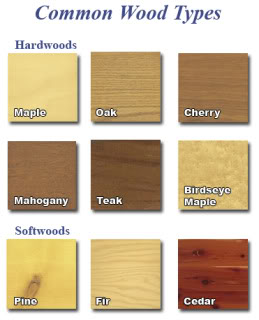Common Types of Wood
A successful wood project is dependent upon the proper selection of wood. An uneducated choice of wood for a deck, closet or even bookcase can lead to all sorts of problems, from rot to termites. Choosing wood doesn't need to be confusing. With the help of a carpenter, you can be sure to choose the right wood. Or read below to understand some of the different characteristics of wood types before starting your project.
You may have heard the term lumber in reference to wood used for building. Lumber simply describes wood to be used for construction work. A lumber yard is where lumber and wood products for construction are sold.
There are two common types of wood: hardwoods and softwoods.
Hardwoods
Hardwoods come from deciduous trees (species which shed their leaves in autumn). Durable, beautiful, and moisture-resistant, hardwoods tend to be more expensive and include mahogany, cherry, maple and oak. These woods are sold by the board foot, which is defined as a square foot of rough lumber that is 1 inch thick. Hardwood flooring is highly prized.
Softwoods
Softwoods come from coniferous trees (cone-bearing trees, which don't lose their foliage) such as evergreens. These woods are most commonly used for home construction and are less expensive than hardwoods, partly because they grow fast and straight. Popular species include pine, fir and redwood. Softwoods are sold in standard thickness and widths.
There are two classifications for lumber generally used: select lumber and common lumber.
Select Lumber
Select lumber includes few defects or blemishes. It's the best choice when appearance is important, such as with fine furniture and bathroom or kitchen cabinets.
Common Lumber
Common lumber contains more blemishes, knots, and other defects. It is used for general building and other home projects.
Select lumber and common lumber are each graded, which makes choosing a wood a bit easier. The grading system is based upon the number of knots and blemishes, and on general quality. Learn more here about lumber grading.
Consult with a local carpenter to determine the best wood for your project.
Updated March 5, 2018.
Looking for a Pro? Call us (866) 441-6648

Carpentry Average Costs
Carpenters Experiences

Concrete Patio Is The Finishing Touch For An Artist's Studio

The Stamped Concrete Patio I’ve Been Waiting For




